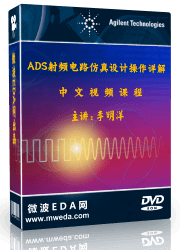- 易迪拓培训,专注于微波、射频、天线设计工程师的培养
mesh option in momentum of ads
I am simulating bandstop filter(5.5G~6.5GHz) in momentum.When i set the stop frequency as 7.5GHz,i got:

And if i set the stop frequency is 8GHz,I can get:

My question,why can i get the different result as i set the different stop frequency?which one is correct?
Thanks,
I guess this is problem of mesh frequency and adaptive samples of simulation frequency.
Is it possible to share the design?
PM me if not desired for broadcast.
Not surprising with ADS momentum simulation, the mesh size is directly related to the stop frequency. You could manually set the mesh solving frequency, thereafter you could get the same result.
I observed the following violations.
1) W33 must be less than L33, design is not flattened once exported to layout.
2) Mesh frequency is set to 3GHZ only but has to be 8GHz
3) no of freq sampling points are limited to 10 only but for filters kind designs requires nearly 40 samples to cover the entire frequency range.









